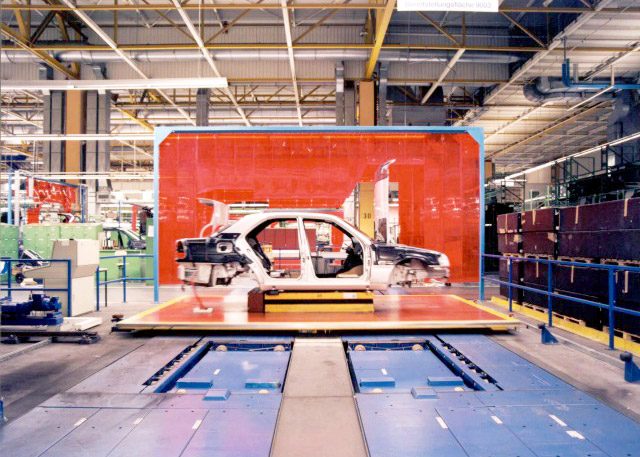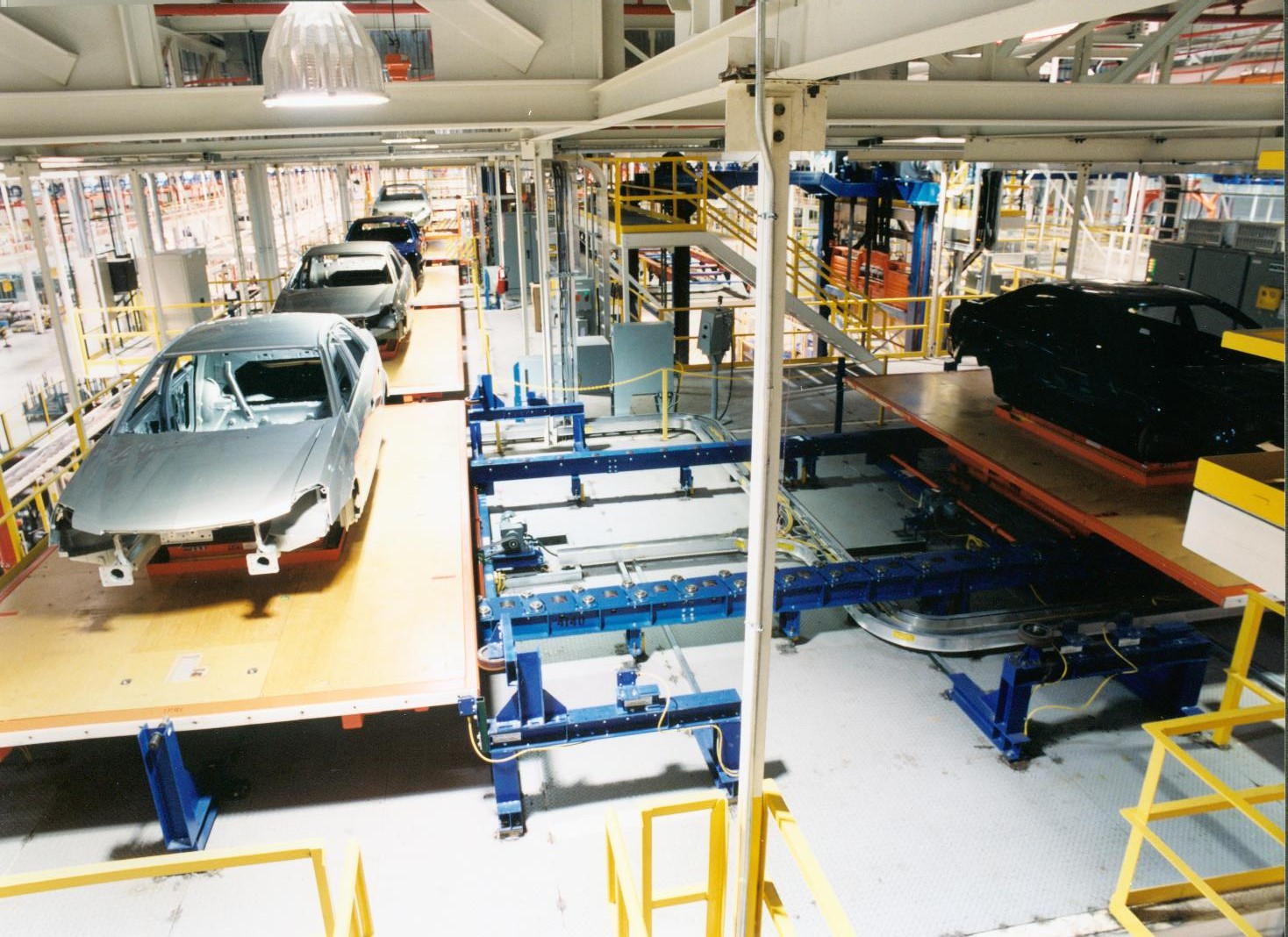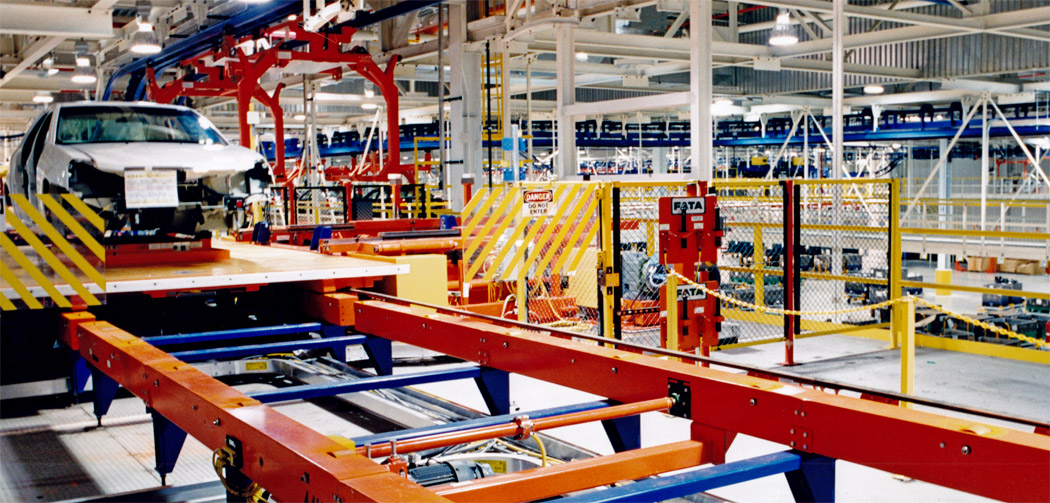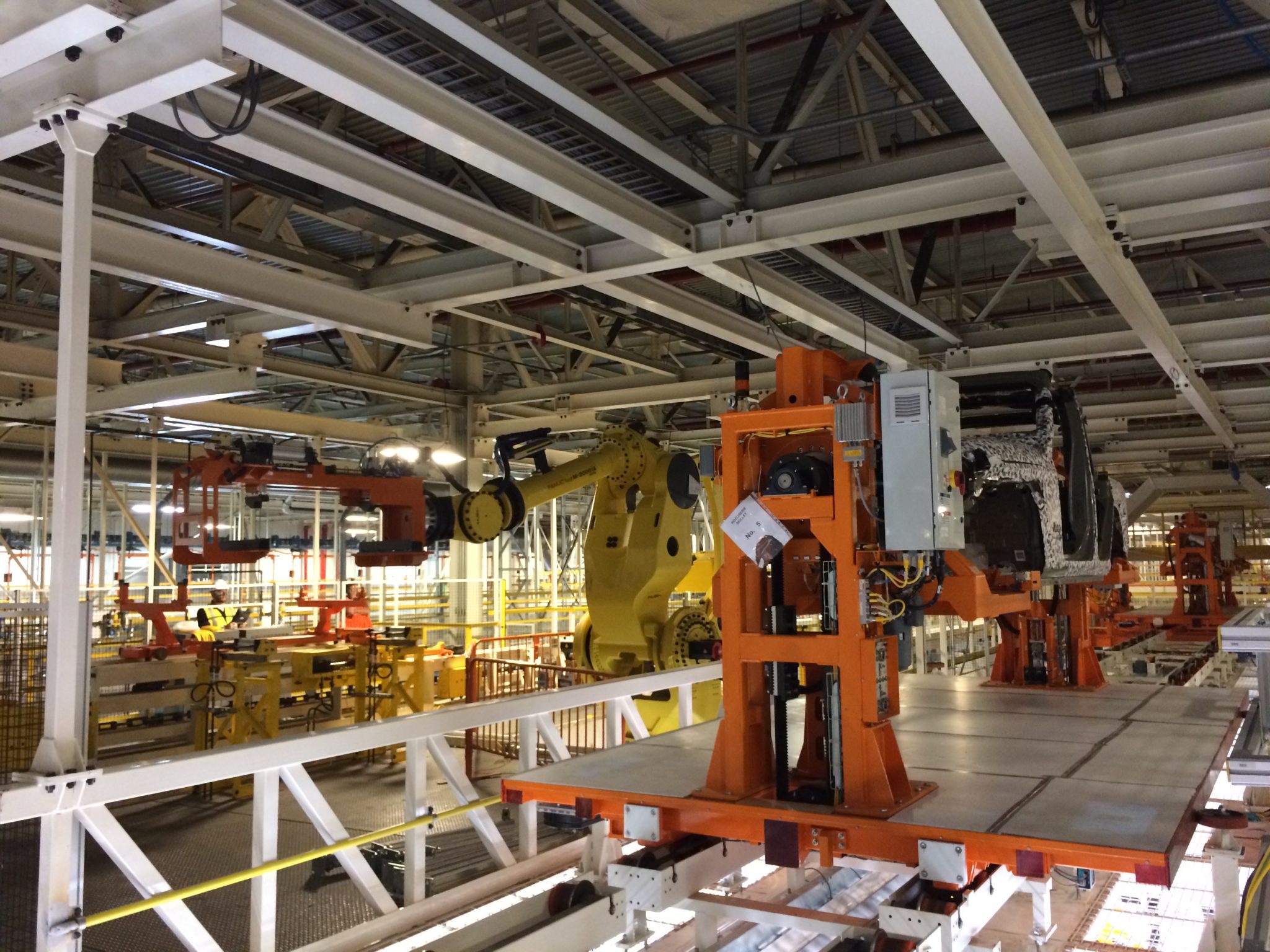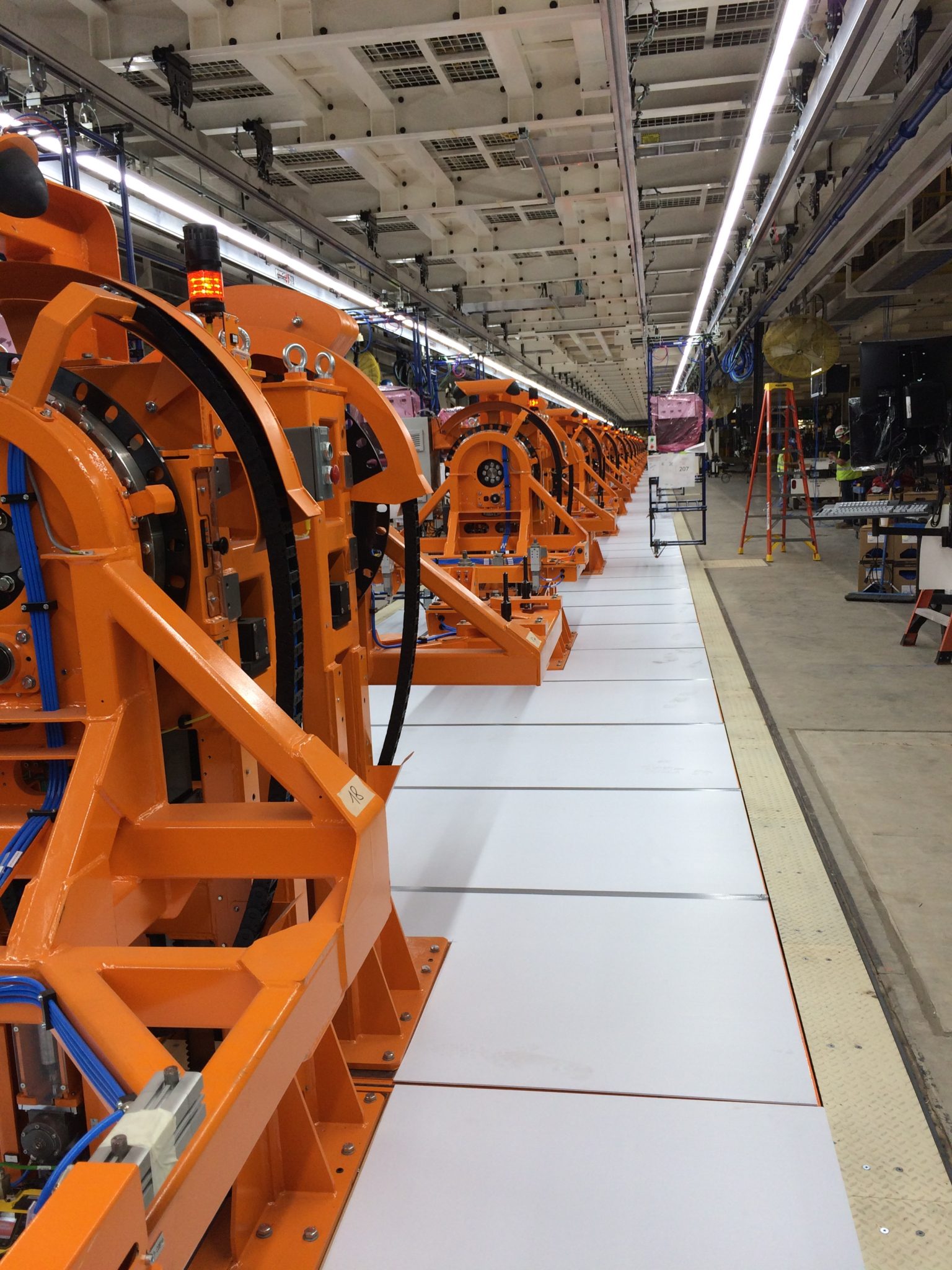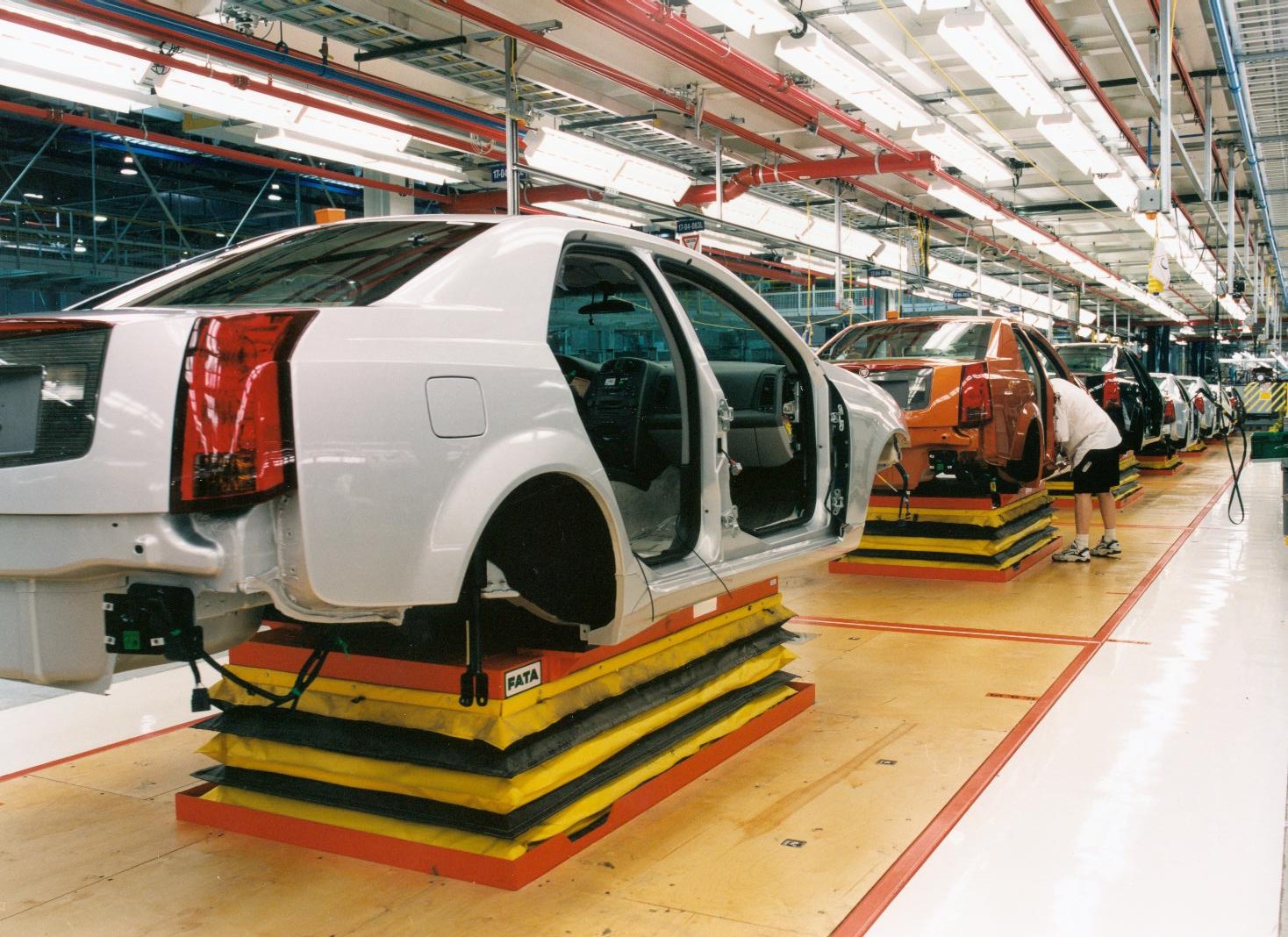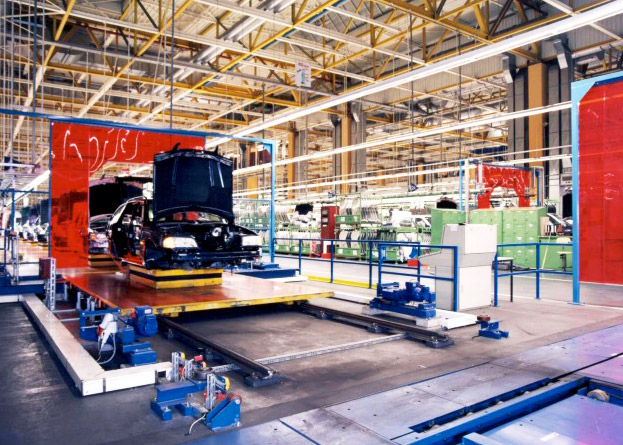Skillet Conveyor Systems
Skillet conveyor (derived from two systems, the Skid system and the Pallet system) is a main line conveyor used typically in General Assembly for trim and final line operations. Skillets (platforms) are conveyed end to end by friction drives called main drive unit that pushes the skillet down the assembly line through various operations. The product is carried on a fixed set of perches or a scissor lift which is an integral part of the skillet. The use of a scissor lift allows the operator to adjust the product to the most ergonomically desirable height for each operation. The slow moving platforms allow the operator to travel with the product providing full universal access to the product. The skillet system can be installed in pits to keep the skillet (platforms) level with the floor or they can be mounted to the floor and used with decking (height ~400mm high). The skillet with a scissor lift on-board receives electrification from a brush/ conductor bar system or from an inductive power system as it is transferred through the production line. The electrification system runs underneath and along the line of production skillets.
At the beginning of the production line is a deceleration drive unit (i.e. docking conveyor) that feeds skillets from offline production conveyor into the production line by decelerating and syncing it to the main line’s production speed as it butts up to the skillet that is in a line of multiple skillets, which forms the production line. At the end of each line is a braking drive unit (i.e. hold back drive) that applies a reversing force that “holds back” on the line of skillets, keeping the skillets in contact throughout the production zone. At the end of the production line is an acceleration drive unit (i.e. undocking conveyor) that speeds-up the skillet to pull it a away from the main line creating a gap allowing the skillet to decouple from the production line.
Once decoupled from the main line the skillet may be propelled longitudinally or laterally through the use of belt driven roller type conveyor. Belt driven roller conveyor designs consist of a longitudinal roller conveyor, cross roller conveyor, eccentric lift roller conveyor, eccentric lift with cross roller and longitudinal roller conveyor, and turntable conveyor. These types of conveyor designs are used to transfer the decoupled skillet to another production line (leg) and to transfer empty skillets back to the beginning of the process line. This may also be accomplished with the use of friction drive type conveyor in-lieu of the roller belt conveyor designs. Friction drive units have rollers that engage the skillet platform’s side edges to propel the skillet supported on idle rollers onto adjoining conveyor equipment.
Material flow needed to feed the production line requires fork truck and pedestrian traffic to cross the skillet line. Vertical drop lifts and/or aisle cross transfer conveyors are used to provide an opening in the skillet system to allow the free flow of traffic to the production lines.
Vertical drop lifts raise the skillet and transfers the skillet on an elevated platform over the aisle and back down to the floor level merging the skillet back into the system allowing an opening for an aisle way. An aisle cross transfer conveyor transfers the skillet on a slat conveyor or a wedge block cam lift conveyor (used with friction drive units). These conveyors are mounted in pits to keep the slats or rail level with floor to allow truck traffic to transfers across it. A traffic light along with safety sensors are required to make the aisle cross transfer conveyor safe for truck and pedestrian crossings.
Vertical drop lifts in-conjunction with belt driven roller conveyor allow flexible solutions to advert building interferences or interferences from other manufacturing systems to maximize space on the manufacturing floor. These conveyors can also be used to transfer the product or empty skillet to elevated platform for buffer and storage requirements.
The product is loaded and unloaded onto and off of the skillet system by the use of a Body Transfer System. See Body Transfer Section for description of this type of system.
All equipment is modular in design, using common components such as rollers, motors and belts.
Power and control signals are delivered to the carriers through a brush/ conductor bus rail system that is integral to the aluminum track. Most common system power requirement is 480 VAC 3-phase. EMS systems can also, be design with 208 VAC 3-phase using a step down transformer from 480 VAC.
Advantages of Skillet System Include:
- Variable speed process capabilities
- Modular component design
- Multiple product capability
- Open access to work inside and around the product
- Improved ergonomics
- Negligible downtime potential
- Minimal downtime for model changeover
- No lubrication system requirement
- No impact accumulation
- Quiet operation
- Low maintenance
Standard Skillet Design:
- Product Weight = 1360 kg (3000 lbs.) – Heavier design weights are available per job application.
- Main Line Production Speeds = Engineered to customer specifications typical line speeds up to 9 mpm (30 fpm)
- Transfer Speeds = up to 45 mpm (150 fpm)
- Skillet Dimensions = Designed per customer requirements
- Skillet Scissor Lift Stroke = 1200 mm (48) – 3000 lb. capacity (ball screw/ belt type lift)
Skillet Conveyor Products Include the Following:
- Skillet
- Scissor Lifts with Anti-fall Safety Device
- Deceleration Drive Unit i.e. Docking Conveyor
- Main Drive Unit
- Braking (hold back) Drive Unit
- Acceleration Drive Unit i.e. Undocking Conveyor
- Encoder Unit
- Longitudinal Roller Conveyor
- Cross Roller Conveyor
- Eccentric Lift with Roller Conveyor
- Eccentric Lift with Cross Roller and Longitudinal Roller Conveyor
- Aisle Transfer Conveyor (Slat Conveyor Design)
- Aisle Transfer Conveyor (Wedge Block Cam Lift Design)
- Vertical Drop/ Lift Unit



